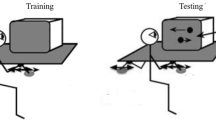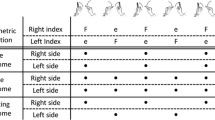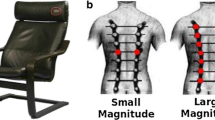Abstract.
In studies of rhythmic coordination, where sensory information is often generated by an auditory stimulus, spatial and temporal variability are known to decrease at points in the movement cycle coincident with the stimulus, a phenomenon known as anchoring (Byblow et al. 1994). Here we hypothesize that the role of anchoring may be to globally stabilize coordination under conditions in which it would otherwise undergo a global coordinative change such as a phase transition. To test this hypothesis, anchoring was studied in a bimanual coordination paradigm in which either inphase or antiphase coordination was produced as auditory pacing stimuli (and hence movement frequency) were scaled over a wide range of frequencies. Two different anchoring conditions were used: a single-metronome condition, in which peak amplitude of right finger flexion coincided with the auditory stimulus; and a double-metronome condition, in which each finger reversal (flexion and extension) occurred simultaneously with the auditory stimuli. Anchored reversal points displayed lower spatial variation than unanchored reversal points, resulting in more symmetric phase plane trajectories in the double- than the single-metronome condition. The global coordination dynamics of the double-metronome condition was also more stable, with transitions from antiphase to inphase occurring less often and at higher movement frequencies than in the single-metronome condition. An extension of the Haken-Kelso-Bunz model of bimanual coordination is presented briefly which includes specific coupling of sensory information to movement through a process we call parametric stabilization. The parametric stabilization model provides a theoretical account of both local effects on the individual movement trajectories (anchoring) and global stabilization of observed coordination patterns, including the delay of phase transitions.
Similar content being viewed by others
Author information
Authors and Affiliations
Additional information
Electronic Publication
Rights and permissions
About this article
Cite this article
Fink, P., Foo, P., Jirsa, V. et al. Local and global stabilization of coordination by sensory information. Exp Brain Res 134, 9–20 (2000). https://doi.org/10.1007/s002210000439
Received:
Accepted:
Issue Date:
DOI: https://doi.org/10.1007/s002210000439




